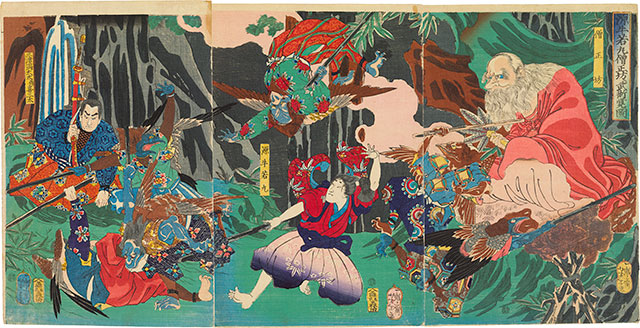

Tsukioka Yoshitoshi, 1839-1892
Ushiwaka Maru learns the martial arts from Sojobo
(Ushiwaka Sojobo ni bujutsu o uku)
signed Ikkaisai Yoshitoshi hitsu, with publisher's seal Mori, Ba Ni, Moriji (Moriya Jihei of Kinshindo), and combined censor and date seal Ushi-juni, aratame (year of the ox [1865], 12th month, examined)
oban tate-e triptych 14 5/8 by 29 3/4 in., 37.1 by 75.6 cm
This composition depicts the legendary warrior Minamoto Yoshitsune (1159-1189) as a young man training in the military arts and strategies with the tengu on Mt. Kurama. At the far left, his loyal servant Kisando (a masterful archer of humble birth) holds a tachi sword at the ready. Of Yoshitsune's exploits, his residency with the tengu is perhaps the most fantastical.
Yoshitsune, identified here with his childhood name Ushiwakamaru, was an itinerant youth who found refuge amongst the fierce tengu (lit. 'heavenly dogs'). The tengu were thought to have been born from giant eggs and have either human or bird-like features. Those who had beaks and wings were called karasu tengu (crow tengu), while those with more human characteristics (often bearing exceptionally long noses) were konoha tengu (tumbling leaf tengu). Both varieties were closely associated with the Shugendo religious order and were often yamabushi (lit 'mountain warriors'), aesthetics who lived in the mountain and blended Buddhist and Taoist theology with supernatural powers and infamous martial abilities.
It is with those creatures that Yoshitsune became an accomplished swordsman and strategist. Under the tutelage of Sojobo, pictured in the right sheet with a flowing white beard, a red robe, and the typically long nose of a konoha tengu, Yoshitsune mastered the arts of war. According to the legend retold in Noh theater, tengu from far flung provinces came to observe and spar with this tremendous young talent. Their acrobatic style was well-suited to the agile, somewhat feminine Yoshitsune, and would become a trademark of his own fighting abilities. He was recognized for his diligence and zealousness as a pupil, and was prophesied by the tengu as the man who would reassert Minamoto dominance over Japan. The mystical beings also warned, however, of his future betrayal at the hands of his brother, Yoritomo.
References:
Edmunds 1974, pp. 623-624
Keyes 1983, p. 365, no. 162
SOLD






